Max: His Life and Loves
The raptors are back! Nope, we’re not talking about dinosaurs from the Cretaceous resurrected by Hollywood, but about our favorite dinosaur descendants, the birds of prey who live in the mews on our Mission Creek Campus. That is, they lived there from 2011 to early fall of 2017, when construction workers got busy transforming the outdoor play space of our Museum Backyard and the birds moved to two generously donated temporary aviaries located in private spaces near the Museum. Now that the new and improved Backyard is almost up and running, the birds have finally come home. It’s been a stressful time for humans and birds alike—with the Thomas Fire and its aftermath delaying construction and prolonging the time the raptors spent in their temporary digs—so the sense of relief here is palpable as our beloved birds return.
These animals can’t survive on their own in the wild. For most of them, that’s due to health conditions like blindness or wing damage sustained during car accidents. Acclimated to life around humans, they do more than earn their keep by acting as ambassadors between the avian world and our own. They’re part of the outreach group Eyes in the Sky (EITS), a program of the Santa Barbara Audubon Society. Every year, the seven birds currently in EITS inspire and inform the schoolchildren they visit in classrooms and the Museum guests who visit the birds here. All this happens because of the dedicated EITS volunteers who care for the birds and act as their interpreters in the community.
I interviewed EITS founder Gabriele Drozdowski in spring, when life in the birds’ impromptu lodgings had just taken a surprising turn. Max—the beloved Great Horned Owl—was in love. That is to say, he was exhibiting behaviors consistent with courting a mate. That in itself wasn’t all that new, but the twist this time was that his would-be mate was another Great Horned Owl…not a human being.
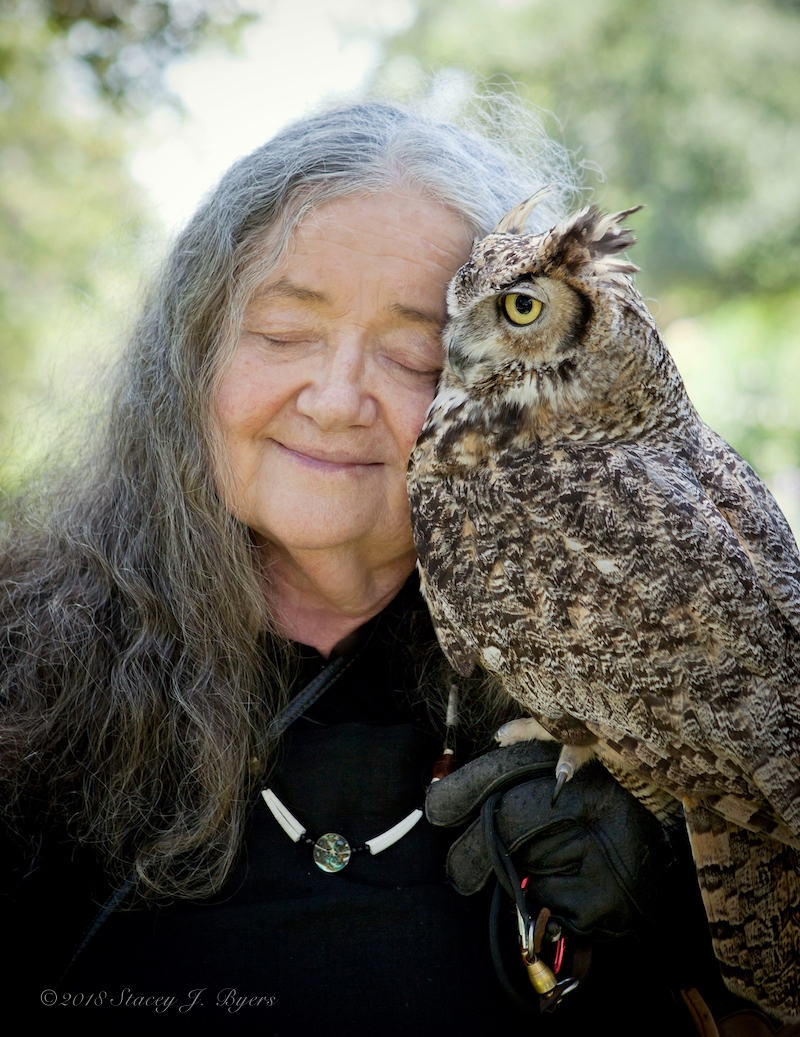
Drozdowski and Max, photo credit: Stacey J. Byers
To unfold the implications of that last sentence, you need to know more about Max. He’s unusual among the EITS birds in that he remains in captivity not because of an injury, but for more complex reasons. He is—in the words of experienced Max-handler and longtime EITS volunteer Bernard Unterman—“a fully-functioning Great Horned Owl. He can’t be released, but he is an awesome Great Horned Owl.” He’ll live out his life among humans because he started it among us.
As a tiny owlet—less than a week old—Max fell from a nest near Ojai. He was found and brought to the Ojai Raptor Center, a bird rescue facility. Because it was early in the season, he was the first owlet there, so instead of interacting with other owls, he interacted exclusively with humans. Other, older owlets arrived later in the season, but unlike Max, as Drozdowski put it, “they already knew they were Great Horned Owls. They hung out together as a group,” and when a human entered their space, they hissed and clacked their beaks in fear. Max, by contrast, had learned to consider humans as a friendly food source. After he learned to fly, whenever a human entered his space, Max would make a begging noise and swoop down to land on their head. This wasn’t a recipe for success in the great outdoors. “At that point we knew,” Drozdowski said, “he was not a good candidate for living out in the wild. We adopted him.”
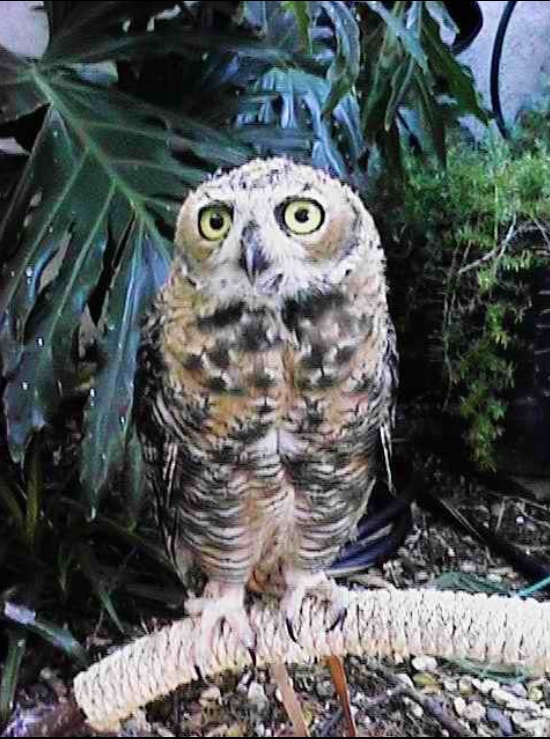
Young Max on the day of his arrival in Drozdowski’s home in 1998
By the time Drozdowski adopted Max in 1998, she had ample experience with bird rescue. During the El Niño of 1991, an influx of warm water reduced the availability of food for local seabirds, and thousands of Santa Barbara birds were starving. Volunteers from Santa Barbara Wildlife Care Network (WCN) rescued hundreds of birds, but there was no adequate space to house them. Drozdowski’s backyard had a pond and an aviary—left behind by a friend who needed a place to store it, and sitting empty for years—so local organizers recruited her and her late husband Jim Walker to the cause of rehabilitating rescued seabirds. They had never worked with birds before. An hour after agreeing to help over the phone, they received their first patient, a Brown Pelican. The memory of that first bird is an emotional one for Drozdowski: “I took one look in that pelican’s eye, and felt like I was looking back thousands of years ago. I saw visions of pelicans in the ocean going back, way back. He connected with me, with the eyes. It was really personal, and I just melted. But that one died, he was too far gone.”
The work was hard, and everything the birds did felt new and surprising. “I was on the phone all the time with the WCN, asking ‘Is this normal’? [Pelicans] do this funny stretching thing with their pouches, and I thought, oh my god, he’s having a seizure!” Bird by bird, Drozdowski learned what was normal behavior for each species, and how best to treat birds with different problems.
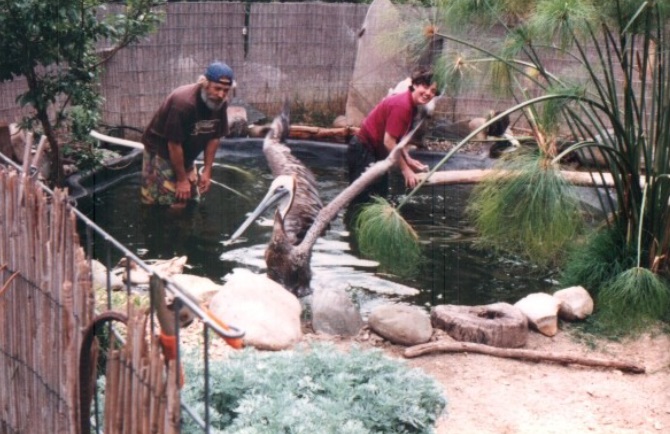
A Brown Pelican in Drozdowski’s backyard pond, c. 1991
For seven years, she and Walker worked with 2,000 pelicans, cormorants, auklets, and others, feeding starving birds and washing oiled ones. Even in the absence of dramatic oil crises, natural oil seepage could be a problem, because while “local birds know how to avoid that . . . the migrants that come down from up north, they don’t know about it, so they get periodically oiled.” Birds can ingest toxic amounts of tar, and oil in their feathers makes them matted and reduces their capacity to insulate, leading to hypothermia. Seabirds tend to be more difficult to rehabilitate than raptors, in part because of their discomfort on land and their reluctance to eat dead fish (which means they have to be tube-fed more often).
By the time Drozdowski met Max, she was planning on taking the year off from helping seabirds. “But I couldn’t stay away [from bird rescue]. I teamed up with the Ojai Raptor Center [then called Wildlife Care Ventura]. I became a satellite station for local raptors with easy problems.” Was Max’s problem easy? While his physical condition wasn’t a worry, the fact that he identified with humans created extraordinary and unique circumstances in Drozdowski and Walker's lives. “I had no idea what kinds of behaviors I could expect from an imprinted owl.” Furthermore, the challenge of living with a permanently captive animal was actually very different from her work rehabilitating purely wild ones. As Drozdowski put it, “Working with wildlife in rehab and working with permanently captive wildlife require two completely different sets of skills: in rehab you try to keep the bird as wild as possible and work hard not to have them like you. In captivity it’s the opposite; you must earn their trust.”
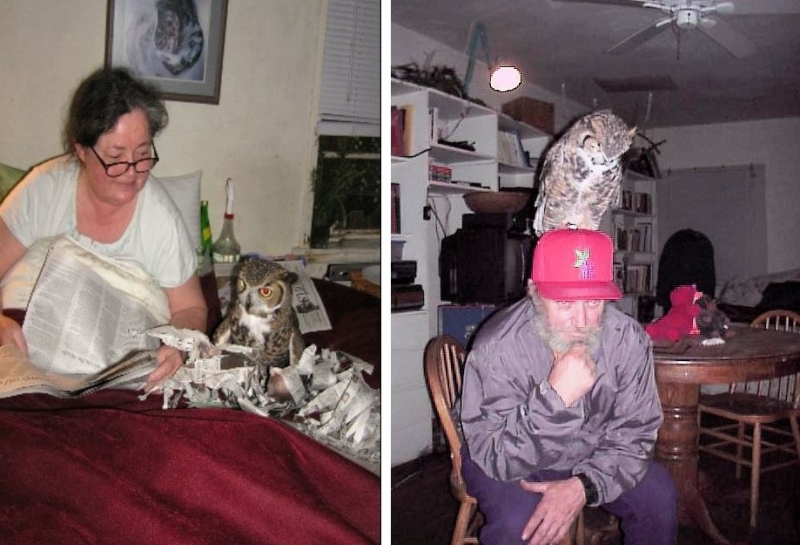
Max at home with Drozdowski and Walker
They earned Max’s trust, and then some. Though he spent his days in their aviary, at night they brought him into their home, where he could have more space to fly and be active. In their house, he did some things you might predict: catching critters and bringing them to humans the way a cat might, and hooting persistently. Eventually he started to give Drozdowski more personal attention, landing on her shoulder and offering her a dead mouse right in her face. Not wishing to be rude, she “politely pretended to nibble on it a little, and offered it back to him.” Before long, he was hooting at her in a different way. From the top of their entertainment center—a newspaper-lined space where he liked to perch, he made this unusual hoot while shredding newsprint with his talons. Drozdowski was perplexed.
Great Horned Owls don’t usually make their own nests, preferring to use nests made by other large birds, or cavities in trees and rocks. If there’s nothing better around, Drozdowski explains, “they will make do with a cliff ledge, and scrape out an indentation with their talons to prevent the eggs from rolling off the ledge.” As she watched Max turning in circles on his ledge and looking at her expectantly, Drozdowski realized that this imprinted owl—who identified so strongly with humans that he had to live with them permanently—looked on her as his mate. This wouldn’t be a brief fling: Great Horned Owls mate for life.
No lurid details here, but suffice it to say that Drozdowski has put up with a lot of scratches during mating season every year as Max attempts to get intimate with her. She puts up with it because, in her words, “one of the responsibilities of keeping captive wild birds is to provide them with the highest quality of life possible. . . I take this responsibility seriously, and I feel quite privileged to be allowed into the personal life” of a wild animal. “But,” she adds dryly, “I did have a line I wouldn’t cross. I never climbed on top of the seven-foot-tall entertainment center, laid eggs, or incubated them for 30 days, while eating only mice.”
“I’m his wife, but he has a mistress now,” Drozdowski said this spring, after the arrival of the Other Woman. Her rival was a female Great Horned Owl who swooped into Max’s life during the shift out of the Museum’s Backyard. “He looks at her underwear from below, while she’s on top of the aviary,” she laughed, without a trace of jealousy.
Unterman related his meeting with Max’s mistress, which happened when he escorted Max home from an awards ceremony at which Drozdowski was honored. He was returning Max to his aviary, which has a net roof. “As I was going in his aviary environment with him, the female arrived,” Unterman recounted, still awestruck by the experience. “She landed on the net roof, and she’s beautiful. She’s huge, it seems like more than a third larger than Max.” Much hooting of a special romantic nature ensued. “I’ve heard the aggressive, get-out-of-my-territory hoots, and it wasn’t that at all,” said Unterman. “She’s hooting beautifully, in a courting-type way, and Max is hooting back at her.” The property owners at the temporary mews and other volunteers observed that female visiting regularly during the summer.
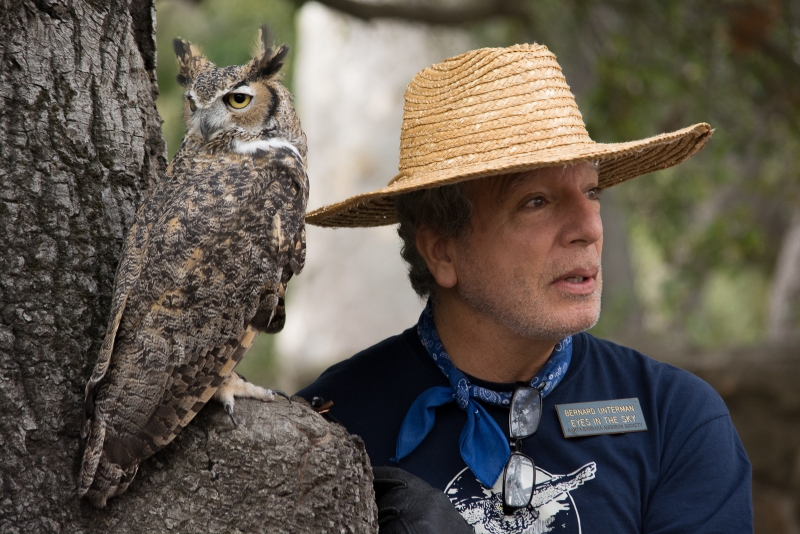
Unterman introducing Max to visitors at an EITS Open House
Once Unterman visited Max on a rainy day, and saw that Max—seemingly preoccupied with the impending visit of his mistress—was uninterested in taking shelter. “Owls don’t like the rain, they seek shelter when it rains,” he explained. “Their feathers are specialized for silent flight, but because of that, their feathers are more delicate. Barn Owls can’t even fly if they get wet.” Red-tailed Hawks, by contrast, can fly in the rain. “Max was soaking wet. I offer Max my arm, he hops right on my arm. I bring him over to the protected dry area, and I’m wanting him to get off my arm to stay where it’s nice and dry. He didn’t want to. He got on that dry spot and immediately flew back into the pouring rain. He’s pacing back and forth, hooting and looking up. He’s looking for her.”
Unterman was concerned that Max would be out there all night. “He was already soaked to the bone. His tufts were completely drooping down and dripping. The poor guy, he looked small, like a wet cat. Neither of us wanted Max out all night long, soaked in the rain, so I took Max that evening to Gabriele’s house.” He dried out there, but was in an inconveniently “amorous mood.”
Who is this mysterious vamp, and where did she come from? Volunteers dubbed her the Wild Widow because they suspected her to be the erstwhile mate of a territorial male in the neighborhood, a Great Horned Owl who’d often engaged in pitched hooting battles with Max. “Every year at mating season,” Unterman explained, Max “does his mating hoots,” an activity which formerly attracted the territorial male. That male “would hoot furiously at Max, Get out of here! And Max would hoot furiously back.”
This male disappeared last year, leaving the unattached female who was already aware of Max’s presence. “We’ve fantasized about letting her in so they can mate,” Unterman admitted. “Max has never had that opportunity.” But there was no guarantee such a meeting would go well, and the risks outweighed the benefits. The architecture of the temporary mews didn’t have any one-way owl valves (a hard phrase to say, an even harder thing to create), and once mated, Max would have had a lot of incentive to try to join her in the wild. It would have become difficult to keep him in, and an escape “would be tragic for Max” because of his unusual dependency on humans.
Max’s hormonal state may have had antisocial side effects for his longtime roommate, Ivan the Red-tailed Hawk. “We’re not sure, we can’t get inside Max’s mind,” Unterman qualified, but as Max started to exhibit territorial behavior towards Ivan, it seemed the likely result of his new romantic interest. “If Ivan’s on the stump—Ivan has his favorite stumps—Max will get on them. When Ivan wants to hop up, [Max] won’t let him. At one point Ivan tried to hop up on the same stump that Max was already on, with his head down, trying to take possession of that stump, and Max started pecking at him . . . they have to be separated.” In the end, a shower curtain was erected between Max and Ivan, separating the territory evenly. But now the barriers are obsolete. The Wild Widow—maybe frustrated by her prospect’s captivity—gave up and ceased visiting, and now Max and Ivan are back in their private spaces in the luxurious accommodations here at the Museum.
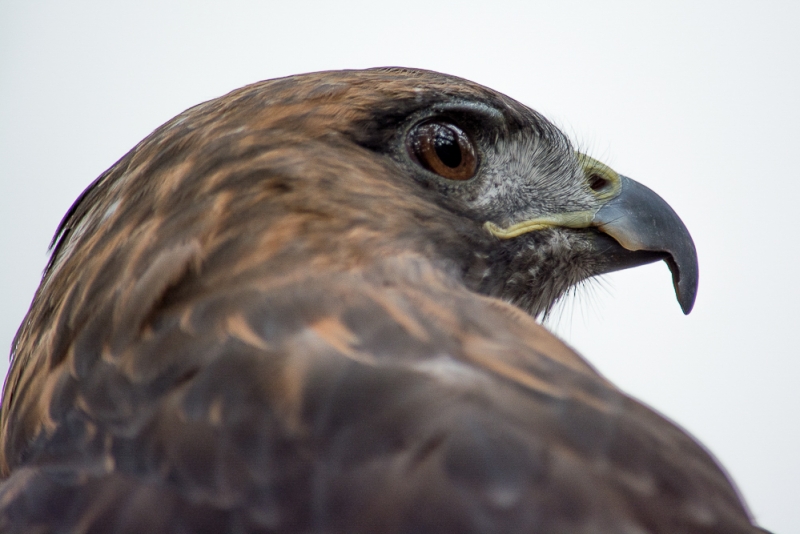
Ivan the Red-tailed Hawk, Max’s roommate
The story of Max and his romantic interests is fascinating—if futile—but the most interesting thing about his life isn’t his status as a frustrated lover, but as an astoundingly successful father. About a year after Drozdowski adopted Max, a young owlet arrived at the Ojai Raptor Center, and like Max, it had no peers to mingle with. “The center’s director and I decided that perhaps we should try to place with Max,” Drozdowski recalled. “Both of us were unsure as to how he would react, so we put the little owlet inside a safe animal carrier that allowed the owlet to see Max, but also kept it safe from unexpected surprises.” After a brief phase of—alarm? Excitement? Who knows what was going through his head as he flew around “panting, with flattened ear tufts, landing hard on his perches”—Max shifted into dad gear and brought one of his own dead mice to feed the owlet.
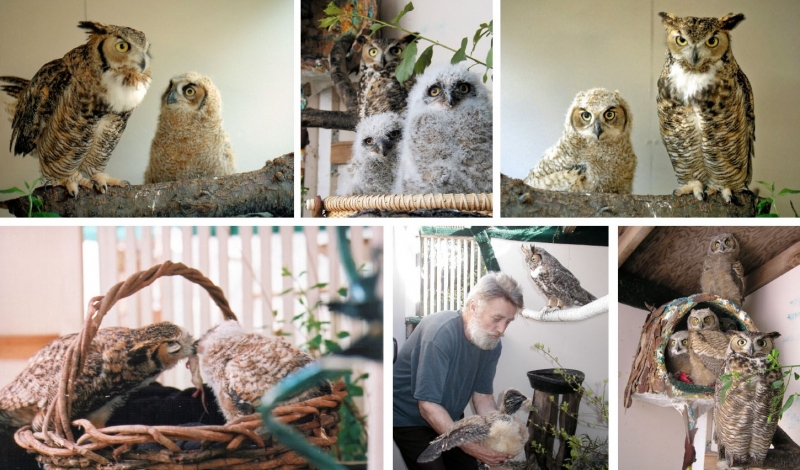
Max, the adopted owl, with some of his many adopted owlets
This was the beginning of an amazing career, during which Max foster-parented 76 orphaned Great Horned Owl chicks. These chicks all grew up with something Max was lacking: an owl role model. Oddly enough, this may also be the part of his life that’s the most difficult not to anthropomorphize. While it’s hard to resist viewing his romances in human terms (betrayed even by the euphemism “romance” itself), how could any human fail to relate to the parental need to provide a better life for our children? In this case, Max is just doing what comes naturally (as are we).
Max has had a long life in which to raise chicks: he’s 20 years old, and wild Great Horned Owls seldom live anywhere near as long. Lately he’s focused on his retirement career as an education bird with EITS. “Max is so famous in Santa Barbara,” Drozdowski told me with pride. “He’s an old trooper. He’s done thousands of programs by now.”
Drozdowski—after decades of service to our local avian and human communities—just retired from leading EITS, and plans to join her children and grandchildren in South Korea. She’ll be missed here, and probably not just by humans. Certainly Max will know his “wife” is missing, though a constant stream of admirers passes through his life. But we know Drozdowski will find birds to love and care for in her new home. After all, having been so close to such amazing creatures, how could you stay away?
If getting to know a Great Horned Owl sounds like something you want to do with your life, you should know that EITS is always recruiting. “We have over 45 volunteers helping with the birds,” said Drozdowski, “and we could still use more.” Chris Mersey, Interim Director of EITS, says that volunteers for Saturdays are especially needed. Most volunteers begin without having any experience working with birds, but there are some required characteristics: good people skills, good animal skills, and above all, reliability and patience. Do you have what it takes? Learn more on the Santa Barbara Audubon website.

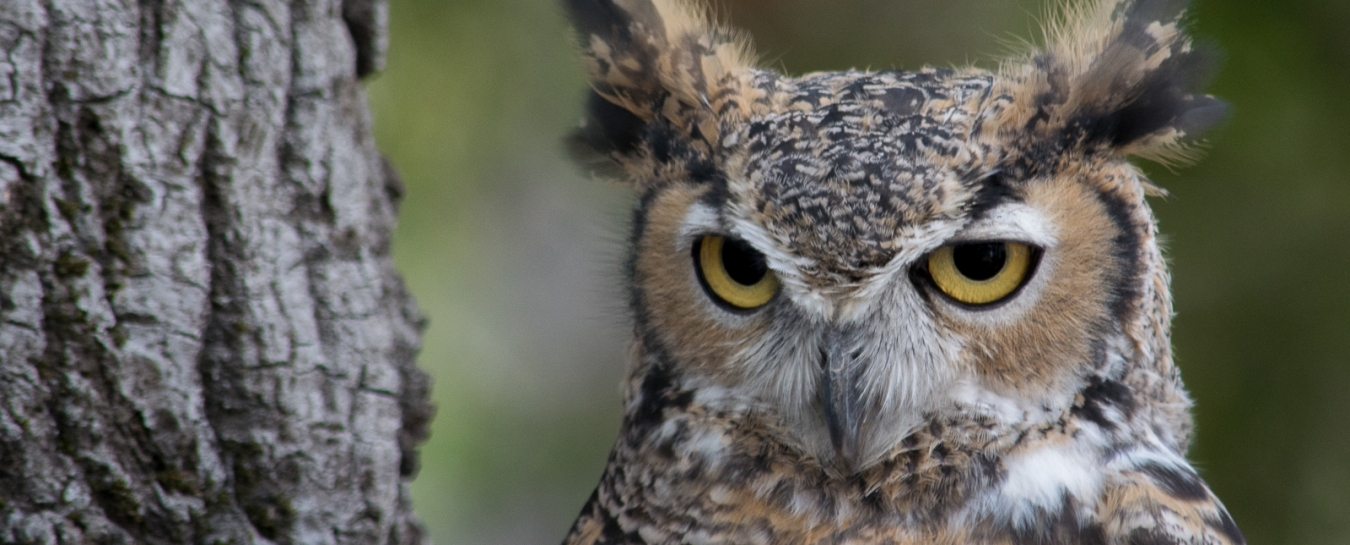
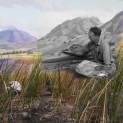
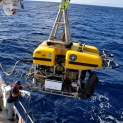
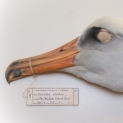


3 Comments
Post a CommentAwesome story about our Eyes in the Sky program, with focus on Max. Excellent writing, Owen!
Marvelous story and written beautifully.
I remember meeting Max when I organized an event with Gabriele for the Santa Barbara Newcomers Club many years ago... He made a lasting impression and I have visited him at the Natural History Museum over the years. We love you Max.